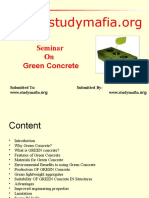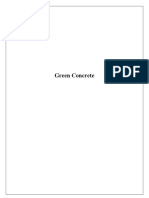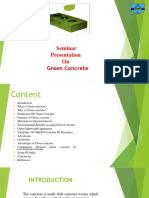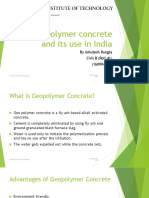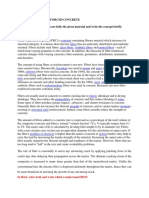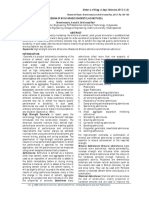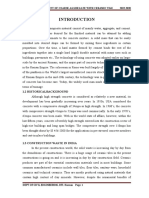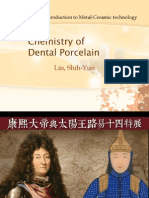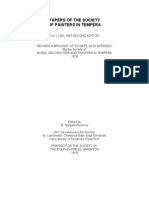100%(1)100% found this document useful (1 vote)
331 viewsGreen Concrete
Green Concrete
Uploaded by
PankajKumarGreen concrete is an environmentally friendly concrete that uses less energy and produces fewer carbon dioxide emissions than traditional concrete. Most of the carbon dioxide in concrete comes from the cement manufacturing process, so green concrete uses materials like fly ash as a partial cement replacement. It has benefits like reduced shrinkage and creep, lower heat production, and uses locally available and recycled materials. Green concrete is suitable for structures as it is lighter weight, more durable, and reduces the concrete industry's carbon dioxide emissions and waste. Its use in India has scope to grow as it can help reduce disposal of industrial wastes and lower environmental impacts.
Copyright:
© All Rights Reserved
Available Formats
Download as PPTX, PDF, TXT or read online from Scribd
Green Concrete
Green Concrete
Uploaded by
PankajKumar100%(1)100% found this document useful (1 vote)
331 views14 pagesGreen concrete is an environmentally friendly concrete that uses less energy and produces fewer carbon dioxide emissions than traditional concrete. Most of the carbon dioxide in concrete comes from the cement manufacturing process, so green concrete uses materials like fly ash as a partial cement replacement. It has benefits like reduced shrinkage and creep, lower heat production, and uses locally available and recycled materials. Green concrete is suitable for structures as it is lighter weight, more durable, and reduces the concrete industry's carbon dioxide emissions and waste. Its use in India has scope to grow as it can help reduce disposal of industrial wastes and lower environmental impacts.
Original Description:
This is Presentation on GREEN CONCRETE
Copyright
© © All Rights Reserved
Available Formats
PPTX, PDF, TXT or read online from Scribd
Share this document
Did you find this document useful?
Is this content inappropriate?
Green concrete is an environmentally friendly concrete that uses less energy and produces fewer carbon dioxide emissions than traditional concrete. Most of the carbon dioxide in concrete comes from the cement manufacturing process, so green concrete uses materials like fly ash as a partial cement replacement. It has benefits like reduced shrinkage and creep, lower heat production, and uses locally available and recycled materials. Green concrete is suitable for structures as it is lighter weight, more durable, and reduces the concrete industry's carbon dioxide emissions and waste. Its use in India has scope to grow as it can help reduce disposal of industrial wastes and lower environmental impacts.
Copyright:
© All Rights Reserved
Available Formats
Download as PPTX, PDF, TXT or read online from Scribd
Download as pptx, pdf, or txt
100%(1)100% found this document useful (1 vote)
331 views14 pagesGreen Concrete
Green Concrete
Uploaded by
PankajKumarGreen concrete is an environmentally friendly concrete that uses less energy and produces fewer carbon dioxide emissions than traditional concrete. Most of the carbon dioxide in concrete comes from the cement manufacturing process, so green concrete uses materials like fly ash as a partial cement replacement. It has benefits like reduced shrinkage and creep, lower heat production, and uses locally available and recycled materials. Green concrete is suitable for structures as it is lighter weight, more durable, and reduces the concrete industry's carbon dioxide emissions and waste. Its use in India has scope to grow as it can help reduce disposal of industrial wastes and lower environmental impacts.
Copyright:
© All Rights Reserved
Available Formats
Download as PPTX, PDF, TXT or read online from Scribd
Download as pptx, pdf, or txt
You are on page 1of 14
At a glance
Powered by AI
The key takeaways are that green concrete aims to reduce the carbon footprint of concrete by using recycled materials and less energy intensive production processes.
Green concrete is environmental friendly concrete that uses less energy in its production and produces less carbon dioxide than normal concrete.
Most of the carbon dioxide in concrete comes from the cement manufacturing process, while a small amount comes from extracting virgin aggregates.
GREEN CONCRETE
1. What is Green Concrete ?
2. Where does the Carbon Dioxide come from in concrete ?
3. Features of Green Concrete
4. Materials for Green Concrete
5. Cementitious materials - Fly Ash
6. Advantage Of Green Concrete
7. SUITABILITY OF GREEN CONCRETE IN STRUCTURES
8. SCOPE IN INDIA
What is Green Concrete ?
Green Concrete is environmental friendly concrete.
Concrete that uses less energy in its production
& produces less carbon dioxide than normal
concrete is Green Concrete
3
Where does the Carbon Dioxide come from in
concrete ?
i) Cement:
Most of CO2 in concrete is from the cement manufacturing process. A
typical cubic meter of concrete contains about 10% cement by weight. The
reaction in the process of Cement manufacture is:
ii) Aggregate:
Use of virgin aggregates contributes about 1% of all CO2 emissions from a
typical cubic meter of concrete. Therefore, the use of alternate aggregate is
desirable. The use of local and recycled aggregates is desirable as it can
reduce transportation and fuel cost and support sustainable development.
4
5
Features of Green Concrete
The concrete which can fall in the category of green must have the
following characteristics.
Optimizes use of available materials
Better Performance
Enhanced cohesion workability / consistency
Reduced shrinkage / creep.
Durability - Better service life of concrete
Reduced carbon footprint
No increase in cost
LEED India Certification
Green concrete mix is designed with the principle of "Particle-Packing
Optimization" to meet requirements of plastic and hardened properties.
6
Materials for Green Concrete
Green construction materials are composed of renewable, rather than non
renewable resources. Green materials are environmentally responsible
because impacts are considered over the life of the product. Depending
upon project-specific goals, green materials may involve an evaluation of
one or more of the following criteria.
1. Locally available
2. Salvaged, re-furnished, or re-manufactured
3. Reusable or recyclable
7
Materials for Green Concrete
Coarse Aggregates are:
Fresh Local Aggregate
Recycled Demolition Waste Aggregate
Blast Furnace Slag (BFS) Recycled Concrete Material (RCM)
8
Materials for Green Concrete
Fine Aggregate s are:
Manufactured Sand For Concrete
Recycled Glass Aggregate
Blast Furnace Slag (BFS) Fly Ash
9
Cementitious materials - Fly Ash
Fly ash is a by-product produced during the operation of coal-fired power
plants. The finely divided particles from the exhaust gases are collected in
electrostatic precipitators. These particles are called Fly ash.
Advantages Of Using Fly Ash in Concrete:
1. Utilization of fly ash as a part replacement of cement or as a mineral
admixture in concrete saves on cement and hence the emission of
CO2.
2. Use of good quality fly ash in concrete has shown remarkable
improvement in durability of concrete, especially in aggressive
environment.
3. Some of the technical benefits of the use of fly ash in Green Concrete
are:
a) Higher ultimate strength
b) Increased durability
c) Improved workability
d) Reduced bleeding
e) Increased resistance to alkali-silica reactivity.
f) Reduced shrinkage.
10
Advantage Of Green Concrete
1. Optimized mix designs mean easier handling, better consistency and
easier finishing.
2. Reduction in shrinkage & creep.
3. Green Concrete uses local and recycled materials in concrete.
4. The heat of hydration of green concrete is significantly lower than
traditional concrete.
5. This result in a lower temperature rise in large concrete pours which
is a distinct advantage for green concrete.
11
12
SUITABILITY OF GREEN CONCRETE IN STRUCTURES
Several factors which enhances the suitability of green concrete in
structures include:
1. Reduce the dead weight of a structure and reduce crane age load; allow
handling, lifting flexibility with lighter weight.
2. Good thermal and fire resistance, sound insulation than the traditional
granite rock.
3. Improve damping resistance of building.
4. Reduction of the concrete industry's CO2-emission by 30 %.
5. Increased concrete industry's use of waste products by 20%.
6. No environmental pollution and sustainable development.
7. Green concrete requires less maintenance and repairs.
8. Compressive strength behaviour of concrete with water cement ratio is
more than that of conventional concrete.
9. Flexural strength of green concrete is almost equal to that of
conventional concrete.
13
SCOPE IN INDIA
Green concrete is a revolutionary topic in the history of concrete industry.
As green concrete is made with concrete wastes it does take more time to
come in India because of industries having problem to dispose wastes and
it also reduces environmental impact with reduction in CO2 emission. Use
of green concrete can help us reduce a lot of wastage of several products.
Various non-biodegradable products can also be used and thus avoiding the
issues of their disposal.
14
You might also like
- Mix Design of Concrete and Properties of Green ConcreteDocument32 pagesMix Design of Concrete and Properties of Green ConcreteShuvanjan Dahal100% (9)
- The Lost Foam Casting ProcessDocument29 pagesThe Lost Foam Casting ProcessPawan Verma100% (5)
- Ferrock: A Carbon Negative Sustainable Concrete: Presented by Abil Chandra BJK18CE001 Guided by Mrs. Jisha B SDocument39 pagesFerrock: A Carbon Negative Sustainable Concrete: Presented by Abil Chandra BJK18CE001 Guided by Mrs. Jisha B SMovie ManiaczzNo ratings yet
- Decorative Concrete SeminarDocument8 pagesDecorative Concrete SeminarMahaManthra100% (2)
- Struto ProductDocument8 pagesStruto ProductMoniruzzaman MoNir100% (1)
- Compounding of PlasticsDocument3 pagesCompounding of PlasticsslchemNo ratings yet
- Green Concrete - Civil EngineeringDocument20 pagesGreen Concrete - Civil EngineeringAmirtarajNo ratings yet
- Civil Green ConcreteDocument18 pagesCivil Green Concretesharukh88% (8)
- Green Concrete: Presented By: Presented ToDocument19 pagesGreen Concrete: Presented By: Presented ToSatyam SatyaNo ratings yet
- Green ConcreteDocument23 pagesGreen ConcreteNisha KaundalNo ratings yet
- Green ConcreteDocument13 pagesGreen ConcreteSanket Chaudhari100% (1)
- Seminar PPT On Green ConcreteDocument16 pagesSeminar PPT On Green ConcreteSandeep Meena75% (8)
- Green - Concrete Seminar ReportDocument23 pagesGreen - Concrete Seminar ReportAmisha SoganNo ratings yet
- Green Concrete SeminarDocument20 pagesGreen Concrete SeminarSelva Prakash67% (9)
- Green Concrete Seminar TopicDocument21 pagesGreen Concrete Seminar TopicAdesh DepangiNo ratings yet
- Green ConcreteDocument12 pagesGreen Concretevaishnavi yedur100% (1)
- Green Concrete: WWW - SeminarDocument12 pagesGreen Concrete: WWW - SeminarSuraj Deb BarmaNo ratings yet
- Seminar Presentation On Green ConcreteDocument22 pagesSeminar Presentation On Green ConcreteMOHINI JAISWALNo ratings yet
- Greenconcrete 151201205108 Lva1 App6891Document21 pagesGreenconcrete 151201205108 Lva1 App6891Judin MathewsNo ratings yet
- Green Concrete SeminarDocument12 pagesGreen Concrete Seminardhwani100% (1)
- My Seminar ReportDocument20 pagesMy Seminar Reportsudhir_9219956000% (2)
- Seminar Report Plastic Road PDFDocument13 pagesSeminar Report Plastic Road PDFAbhinav YadavNo ratings yet
- Project Report On Polymer Fibre Reinforced Concrete PavementsDocument41 pagesProject Report On Polymer Fibre Reinforced Concrete PavementsShilankarMurti82% (17)
- F-Admixture Project ThesisDocument61 pagesF-Admixture Project Thesismuhammad najeebNo ratings yet
- Green ConcreteDocument20 pagesGreen ConcretePankajKumar75% (12)
- Studies On Quarry Dust As Partial Replacement of Fine Aggregates in ConcreteDocument3 pagesStudies On Quarry Dust As Partial Replacement of Fine Aggregates in ConcreteEditor IJLTEMASNo ratings yet
- Project Synopsis FormatDocument13 pagesProject Synopsis FormatMomin Abu HuzaifaNo ratings yet
- Recycled AggregatesDocument31 pagesRecycled Aggregatesshailesh goral56% (9)
- Replacement of Coarse Aggregate by Cinder Aggregate in Light Weight Concrete.Document27 pagesReplacement of Coarse Aggregate by Cinder Aggregate in Light Weight Concrete.Parashu Ram Neo100% (1)
- Comparative Study of Polymer Fibre Reinforced Concrete With Conventional Concrete PavementDocument5 pagesComparative Study of Polymer Fibre Reinforced Concrete With Conventional Concrete PavementesatjournalsNo ratings yet
- Replacement of Cement Using Fly AshDocument22 pagesReplacement of Cement Using Fly Ashkaushal yadavNo ratings yet
- Alternatives of Sand PDFDocument27 pagesAlternatives of Sand PDFRaviteja100% (1)
- Plastic RoadsDocument16 pagesPlastic RoadsAbhinav Yadav100% (1)
- Seminar Report - Green ConcreteDocument29 pagesSeminar Report - Green ConcreteAbhinav Srivastava78% (85)
- Aac Blocks PPT 1Document13 pagesAac Blocks PPT 1Bhagyashree VenturesNo ratings yet
- Ijetae 1014 72Document8 pagesIjetae 1014 72Charan ReddyNo ratings yet
- Compressive Strength of Concret by Fly AshDocument16 pagesCompressive Strength of Concret by Fly AsheranjanishuklaNo ratings yet
- MsandDocument4 pagesMsandKote Bhanu PrakashNo ratings yet
- Green: A Seminar Report OnDocument29 pagesGreen: A Seminar Report OnManish kumarNo ratings yet
- Cement Replacement Wood WasteDocument9 pagesCement Replacement Wood WasteEva N. TayNo ratings yet
- Geo Polymer ConcreteDocument17 pagesGeo Polymer ConcreteAshutosh RungtaNo ratings yet
- Evaluation of Mechanical and Durability Propierties of Concrete Paving Block Containing Granite Slurry WasteDocument62 pagesEvaluation of Mechanical and Durability Propierties of Concrete Paving Block Containing Granite Slurry WasteRomeo R Chinguel DelgadoNo ratings yet
- Notes On Fibre Reinforced ConcreteDocument9 pagesNotes On Fibre Reinforced ConcreteK.ANISH100% (1)
- Final Project ReportDocument40 pagesFinal Project Reportmariam100% (1)
- Plastic Roads - Akashchakole PDFDocument27 pagesPlastic Roads - Akashchakole PDFAnn CruzNo ratings yet
- Paper Presentation On Green BuildingDocument14 pagesPaper Presentation On Green BuildingSurya VasuNo ratings yet
- Civil EngineeringProjectDocument9 pagesCivil EngineeringProjectMitendra Singh100% (1)
- Fly Ash BricksDocument18 pagesFly Ash BricksMS PM100% (1)
- Geopolymer Bricks With Unique Withstanding StrengthDocument41 pagesGeopolymer Bricks With Unique Withstanding StrengthMohammed Saleem Syed KhaderNo ratings yet
- MINI PROJECT REPORT. (Original)Document19 pagesMINI PROJECT REPORT. (Original)Yashaswi M Gowda100% (1)
- Methodology For Prevention and Repair of Cracks in BuildingDocument7 pagesMethodology For Prevention and Repair of Cracks in BuildingGRD JournalsNo ratings yet
- Design of M100 Grade ACI MethodDocument3 pagesDesign of M100 Grade ACI MethodGaurav PatilNo ratings yet
- Study On Replacement of Limestone Calcined Clay With Cement in MortarDocument9 pagesStudy On Replacement of Limestone Calcined Clay With Cement in MortarKamal KishoreNo ratings yet
- 1.1 Concrete: Partial Replacement of Coarse Aggregate With Ceramic Tile 2019-2020Document25 pages1.1 Concrete: Partial Replacement of Coarse Aggregate With Ceramic Tile 2019-2020Naveen S100% (2)
- High Strength Concrete (M70)Document41 pagesHigh Strength Concrete (M70)Anik Yadav50% (2)
- Soil Reinforcement 1Document24 pagesSoil Reinforcement 1Rajat Mangal50% (2)
- Project Report Self Curing ConcreteDocument34 pagesProject Report Self Curing ConcreteJai PrakashNo ratings yet
- Durability of Concrete, PowerpointDocument6 pagesDurability of Concrete, PowerpointShepherd NhangaNo ratings yet
- PPTDocument28 pagesPPTRama Arul SakthiNo ratings yet
- Seminar Report On Decorative Concrete 2015-2016Document30 pagesSeminar Report On Decorative Concrete 2015-2016Archana Mol100% (1)
- RECYCLED AGGREGATES in CONCRETEDocument9 pagesRECYCLED AGGREGATES in CONCRETECptcafecpt Cptcafe100% (1)
- Fibre Reinforced ConcreteDocument21 pagesFibre Reinforced ConcreteAnand PradhanNo ratings yet
- Green ConcreteDocument14 pagesGreen ConcreteChitransh RajatNo ratings yet
- Marshall ReportDocument12 pagesMarshall ReportZulfadhli Zullkeply100% (1)
- TR4 - Listing of HDB-PDB-MRS For Thermoplastic Piping MaterialsDocument66 pagesTR4 - Listing of HDB-PDB-MRS For Thermoplastic Piping MaterialsRyan Carter100% (1)
- Fire ExtinguisherDocument8 pagesFire ExtinguisherAzrif MoskamNo ratings yet
- MechanicalDocument173 pagesMechanicalKerx Endrano100% (1)
- RCC2Document18 pagesRCC2Mangam RajkumarNo ratings yet
- Plumbing: Wholesale CatalogDocument92 pagesPlumbing: Wholesale CatalogTan Kang YaoNo ratings yet
- Brederoshaw Pds 3lpeDocument2 pagesBrederoshaw Pds 3lpeadvis79No ratings yet
- TMT4145 Ceramics EngineeringDocument26 pagesTMT4145 Ceramics EngineeringAngga Yogi PrasetiaNo ratings yet
- A Bag For All Reasons All ReasonsDocument10 pagesA Bag For All Reasons All ReasonsAna Karina Pereira100% (1)
- Anthony Ryder Colour RecommendationDocument2 pagesAnthony Ryder Colour RecommendationbhaumiksauravNo ratings yet
- Texturized PETDocument2 pagesTexturized PETGauri PuranikNo ratings yet
- Chemistry of Dental PorcelainDocument98 pagesChemistry of Dental PorcelainShih-Yun Lin100% (1)
- CAT 4660 Section E Hose FittingsDocument128 pagesCAT 4660 Section E Hose FittingsPartsGopher.comNo ratings yet
- Epoxy InstructionsDocument1 pageEpoxy Instructionskarenth23No ratings yet
- SSR DataDocument251 pagesSSR DataVenkata KrishnaNo ratings yet
- Materials For LumbungDocument7 pagesMaterials For LumbungIssnadewi Paramitha WiryaNo ratings yet
- DR Fixit Pidiseal PS 41G and 42P 112 1Document4 pagesDR Fixit Pidiseal PS 41G and 42P 112 1Avinash GuptaNo ratings yet
- Great Minds of Carbon Equivalent - 1 PDFDocument3 pagesGreat Minds of Carbon Equivalent - 1 PDFSiva SubramaniNo ratings yet
- Pintura em TemperaDocument59 pagesPintura em TemperaAnamaria Durval da SilvaNo ratings yet
- Product Technical Guide For Self Drilling Screws Technical Information ASSET DOC LOC 1577675 PDFDocument12 pagesProduct Technical Guide For Self Drilling Screws Technical Information ASSET DOC LOC 1577675 PDFMahmoud GwailyNo ratings yet
- Wall FinishesDocument40 pagesWall FinishesAbhishek Kadian100% (2)
- TDS Dismantling JointsDocument5 pagesTDS Dismantling JointsTanmoy DuttaNo ratings yet
- Material SelectionDocument58 pagesMaterial SelectionSivareddy InduriNo ratings yet
- Falcon Polishing StonesDocument20 pagesFalcon Polishing StonesjhscribdaccNo ratings yet
- HSC Vendor ApplicationDocument2 pagesHSC Vendor Application9823458877No ratings yet
- Aluminium Diecasting MaterialDocument2 pagesAluminium Diecasting MaterialzainudinNo ratings yet







